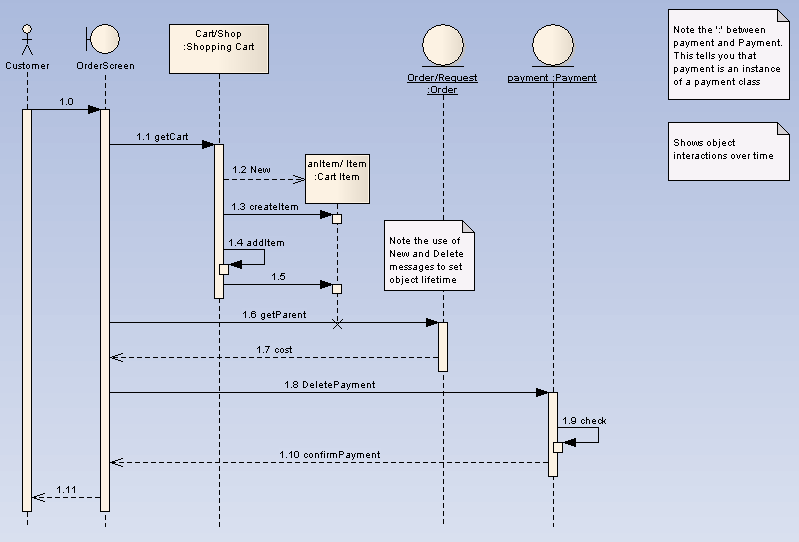
- #Sequence diagram in enterprise architect manual#
- #Sequence diagram in enterprise architect full#
- #Sequence diagram in enterprise architect plus#
- #Sequence diagram in enterprise architect series#
For example, a student enrolls in the university, and then immediately enrolls in three seminars. The logic of a usage scenario may also be a pass through the logic contained in several use cases.
#Sequence diagram in enterprise architect plus#
It may also be one entire pass through a use case, such as the logic described by the basic course of action or a portion of the basic course of action, plus one or more alternate scenarios. The logic of a usage scenario may be part of a use case, perhaps an alternate course. A usage scenario is a description of a potential way your system is used. Sequence diagrams, along with class diagrams and physical data models are in my opinion the most important design-level models for modern business application development.Sequence diagrams are typically used to model: Other dynamic modeling techniques include activity diagramming, communication diagramming, timing diagramming, and interaction overview diagramming. Sequence diagrams are the most popular UML artifact for dynamic modeling, which focuses on identifying the behavior within your system. PlantUML = Split(theSelectedElement.UML sequence diagrams model the flow of logic within your system in a visual manner, enabling you both to document and validate your logic, and are commonly used for both analysis and design purposes. ‘the following check is not really required.Īnd theSelectedElement.ObjectType = otElement _Īnd theSelectedElement.Type = “Note” then then this script has not been called properly I hope I can post it successfully.Ĭall LOGInfo(“Create Sequence Diagram script activated”) I should have modified the following function for trim to take into account the timeline as well. I had to increase the number of judgment conditions, so I put the judgment elements into an array. This problem occurred when a dotted line was specified in the PlantUML line pattern. TBC (Itay/Stas): where to write performance data?įound a bug that converted asynchronous response messages into synchronous response messages. Tvp->cache: check cache for entitlement\nto each channel in listĪpp->app: Stop performance\ntest use case timerĪpp->: write test execution time to output
#Sequence diagram in enterprise architect series#
– are these API calls made in series or parallel? – multi-request used (presumably not since not personalised)? – max number of channels this can be called for in one loop?ĭepends on number of channels in “fold” and whether any other

Tvp->cache: check cache for channel’s EPG data Loop For each channel to be displayed in “fold” Tvp->tvp: determine channels to\ndisplay in current EPG\nscreen (“fold”) Tvp->tvp: get list of top most viewed channels

Tvp->cache: check cache for favorite data as can be accessed in the following ways:

Looks like actions require a ‘space’ delimiter, like “user -> app: Display EPG grid” instead of “user->app: Display EPG grid”Īpp->app: Start performance\ntest use case timerĮ.g. Tried to apply your script to the sequence below and got several errors.Įrror on: sequence_array (s,1) = word(1) “Subscript out of range” on the first row I remove this row (and autonumber), it fails on the “boundary” record, etc. message grouping (alt, loop, critical etc).synchronous, asynchronous, return and message to self flows.color coding using either #RGB or HTML standard colors.participant types of actor, control, boundary, entity and database.The following screen shot provide an example of what functionality is offered by the scripts. So one solution to close this gap, I have cobbled together a VBScript to run with Enterprise Architect to allow a modeller to Generate a Sequence Diagram using a PlantUML script. PlantUML does support XMI export, however at this point it only applies to Class diagrams.
#Sequence diagram in enterprise architect full#
The simplest being CSV imports, for high order elements, through to XMI import/export for full element, association and diagrams objects. The solution centres around the ability to exchange models between the modelling platform and the script based diagraming tools.Įnterprise Architect does offer a number of methods for model exchange. where Enterprise and Delivery teams operating at differing speeds can effectively work together.

The cost savings from the speedy delivery of fit for purpose models is long forgotten when the time comes to make changes.
#Sequence diagram in enterprise architect manual#
Validation and alignment against the Domain and or Enterprise landscape would typically be manual and the likely outcome would be model divergence. The problem however it that the PlantUML script used to generate the diagrams are discrete declarations of behaviour. The PlantUML script can be published and made available for collaboration. I am a fan of PlantUML it is accessible, easy to use and you produce nice looking diagrams with minimal effort in a short period of time.


 0 kommentar(er)
0 kommentar(er)
